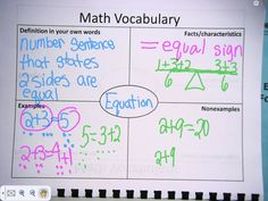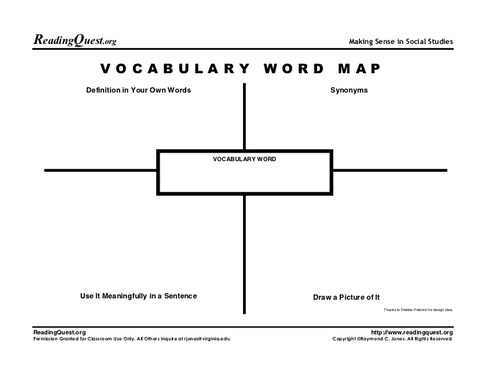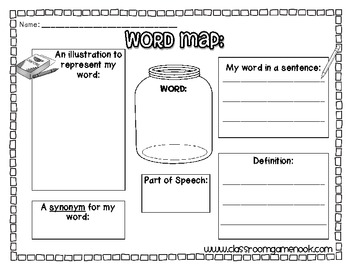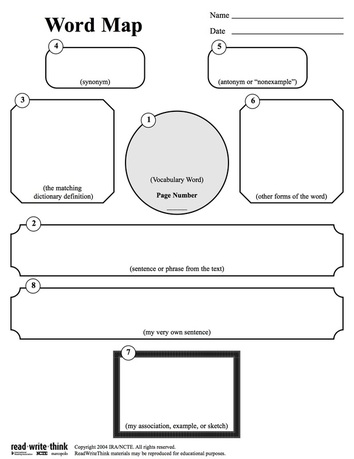What is a Word Map?
A word map is a strategy to help learners learn new vocabulary word. There are many different variations of how to use this strategy. One way is to use the four-corner vocabulary chart, and with this method students write the definition, use it in a sentence, they draw picture of the word, and write the word in the corner. Other methods to use this strategy is to add antonyms, synonyms, dictionary definitions, part of speech and more. This strategy can be adjusted to meet the needs of all learners. Throughout this strategy students are making personal connections, because they are drawing their own picture, writing their own sentence and the definition in their own words. By doing this, it gives more meaning to learning the vocabulary word, and this would help struggling readers tremendously. Graphic organizers are helpful for all learners because it really helps them organize their thoughts. According to Echevarria, Vogt & Short (2014), “These charts provide more context and “clues” than typical word walls, because they include an illustration, definition, and sentence for each vocabulary word" (p.81). According to Robert Marzano (2009), an educational researcher, he mentions that in order for students to effectively learn vocabulary they need to follow a six-step process. The steps are as followed:
1. "Provide a description, explanation, or example of the new term.
2. Ask students to restate the description, explanation, or example in their own words.
3. Ask students to construct a picture, pictograph, or symbolic representation of the term.
4. Engage students periodically in activities that help them add to their knowledge of the terms in their vocabulary notebooks.
5. Periodically ask students to discuss the terms with one another.
6. Involve students periodically in games that enable them to play with terms". (Marzano, 2009).
The first three steps are in a word map. The following three steps can be done after the word map has been completed.
1. "Provide a description, explanation, or example of the new term.
2. Ask students to restate the description, explanation, or example in their own words.
3. Ask students to construct a picture, pictograph, or symbolic representation of the term.
4. Engage students periodically in activities that help them add to their knowledge of the terms in their vocabulary notebooks.
5. Periodically ask students to discuss the terms with one another.
6. Involve students periodically in games that enable them to play with terms". (Marzano, 2009).
The first three steps are in a word map. The following three steps can be done after the word map has been completed.
Visual Representations
|
The image above is an example of a very common word map. In this word map, students write the vocabulary word in the center, they define the word, provide synonyms, use it in a sentence, and draw a picture of it.
|
In this example above students go into more detail with the word. They find the synonym, antonym, dictionary definition, sentence from the text and other forms of the word.
The image to the left is similar to the other two word maps above. Students write the word, use it in a sentence, write the definition, find a synonym for the word, illustrate it and determine it's part of speech.
|
Content Area Examples

Math- For a math lesson, a word map can be easily adapted just like in the photo to the left. In one corner the student can write the word, in another corner the student can write the definition. In the other two corners students can write an example and then some facts to go along with the math vocabulary word. By providing examples it brings meaning to the word, just like a picture does when learning reading vocabulary words.
History- For a history lesson, one way to adapt this strategy is to change the headings slightly. On this graphic organizer it could include: the vocabulary word, time period, definition, and picture. By adding the time period it gives an understanding of when the word was used, and it give more meaning to the word. For example if a student is learning about what a Red Coat is, they could write Revolutionary War (1775-1783) in the time period section.
Science- For a science lesson, the template would not change very much. However, a teacher could ask the student what area of science the word falls under. This might help students categorize what vocabulary words belong where. For example, if the vocabulary word is cumulus, the area of science might be meteorology.
Physical Education- For a physical education lesson, a student could still write the word, draw picture, define the word, and maybe list games they can play relating to the topic. For example, if students are learning about basketball students can list lightning, 3 vs. 3, and others for possible games they could play.
History- For a history lesson, one way to adapt this strategy is to change the headings slightly. On this graphic organizer it could include: the vocabulary word, time period, definition, and picture. By adding the time period it gives an understanding of when the word was used, and it give more meaning to the word. For example if a student is learning about what a Red Coat is, they could write Revolutionary War (1775-1783) in the time period section.
Science- For a science lesson, the template would not change very much. However, a teacher could ask the student what area of science the word falls under. This might help students categorize what vocabulary words belong where. For example, if the vocabulary word is cumulus, the area of science might be meteorology.
Physical Education- For a physical education lesson, a student could still write the word, draw picture, define the word, and maybe list games they can play relating to the topic. For example, if students are learning about basketball students can list lightning, 3 vs. 3, and others for possible games they could play.



